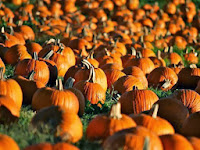Hace ocho meses que no publico nada en el blog y sin embargo he seguido recibiendo visitas, imagino de blogueros curiosos por ver si había algo nuevo. Para celebrar los casi 3.000 (¡increíble!) visitantes anónimos, he decidido publicar una nueva entrada. Ojalá que pueda ser interesante para alguien más, como lo ha sido para mí descubrir que existe una conexión entre la celebración de la fiesta anglosajona de Halloween y la fiesta de Samhain en Galicia.
Y para poner en práctica el inglés que estoy aprendiendo, el tema elegido ha sido el Halloween gallego, llamado Samhain, de profundas y antiguas raíces celtas.
The Old New
Halloween in Spain. Halloween is a new
phenomenon in Spain. But in the Northern, Halloween is celebrated with more enthusiasm
than in the rest of the country, and the reasons are profoundly ancestral. Many
regions in Northern Spain claim archaeological evidence for early
Celtic-speaking inhabitants who arrived between 3,000 and 2,500 years ago in Iberia
and mixed with the indigenous Iberians, or made their way into remote reaches
of the north and northwest and created their own cultural region there.
In
these regions today there is a growing Celtic revival that couples with interest
in related holidays imported from other Celtic-loving lands. One is Halloween, better called Samhain*, “la Noche de los Muertos”
(Night of the Dead). In Galicia, a region in the Northwest, famous for its rich
local folklore and ghost legends, the night of 31st of October is known as, Noite dos Calacús (Night of the
Pumpkins) and is celebrated with pumpkin
carving, costume parties, light bonfires and Queimadas** — the local fire water infused with herbs and set aflame.
It’s a strong alcoholic drink usually made with “aguardiente,
orujo”, coffee beans, sugar and lemon or
orange peels. Traditionally, it’s prepared within a pumpkin and
consumed after reciting a spell (esconxuro or conxuro)— a proclaimed ancient drink of their Celtic ancestors. It is
linked symbolically to the act of burning off bad luck and clearing dark
energies at this dangerous time of year. In these areas you might discover
modern-day druids and priestesses taking the “thinning of the veil between worlds”
very seriously.
Sunset on Samhain is the beginning of the Celtic New Year. The old year
has passed, the harvest has been gathered, cattle and sheep have been brought
in from the fields, and the leaves have fallen from the trees. The earth slowly
begins to die around us. Samhain is when we honor our ancestors who came before us. This is the
perfect night to celebrate their memory. If we’re fortunate, they will return
to communicate with us from beyond the veil, and offer advice, protection and
guidance for the upcoming year. It was the biggest and most significant holiday
of the Celtic year.
By the way, I forgot to say that I was born in Galicia. And well, the Samhain is
coming, so I should start to make my pumpkin & magic potion “queimada” to honor the ancestors. Go ahead!
Have a Great and Terrifying Samhain or
Halloween!
*Samhain
(pronounced /ˈsɑːwɪn/ SAH-win or /ˈsaʊ.ɪn/ SOW-in) is a Gaelic
festival marking the end of the harvest
season and the beginning of winter or the "darker half"
of the year. It is celebrated from sunset on 31 October to sunset on 1
November, which is nearly halfway between the autumn
equinox and the winter
solstice. Along with Imbolc, Beltane
and Lughnasadh it
makes up the four Gaelic seasonal festivals. It was observed in Ireland, Scotland
and the Isle of Man. Kindred
festivals were held at the same time of year in other Celtic
lands; for example the Brythonic Calan
Gaeaf (in Wales), Kalan Gwav
(in Cornwall)
and Kalan Goañv (in Brittany).
**The ancient Celtic ritual of Queimada (kay-MAH-da): Legend says that the first sip of the
Queimada purifies the soul by banishing out evil spirits, the second cleans the
mind of prejudices, and the third gives rise to passion. This pagan ritual dates back to the
eleventh century when Celtic tribes roamed the north western Spanish providence
of Galicia.




Examining this post served me to comprehend 1 or
ResponderEliminar2 facts I was ignorant of!
Also visit my blog :: zoloft withdrawal dizziness; healthsoul.insanejournal.com,